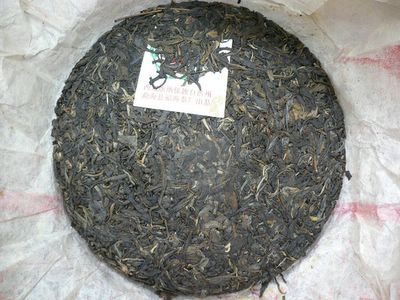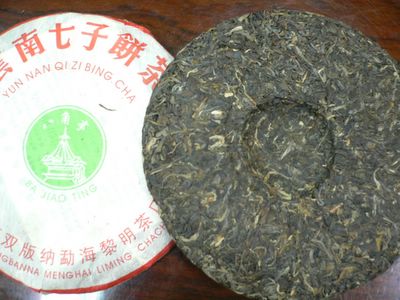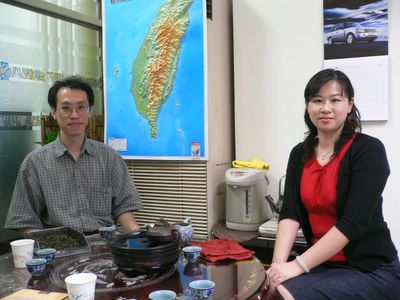I am going to make a lot of jealous blog readers today. To compensate for your thirst I will share what I learned yeasterday with my tea master
Teaparker.
Pu er trees can be classified in 3 categories:
1. (The best) They grow naturally in their original location. They are neither planted, nor taken care by man.
2. In between are the old and big pu er trees that have been planted by man many generations ago, but are not managed by man anymore.
3. Then there are the pu er trees, planted and taken care by the tea farmers.
For all these trees, you can further separate between big and small leaves. Leave size does not influence the drinking pleasure!
First, we tasted wild Meng Ku loose leaves vs. a (fake) wild Si Shou pu er. We used
nanowater and a silver teapot. I found the nanowater a little bit itchy on my tongue, like a very soft 'soda' effect. This very lively water suits pu er well, but would be too strong with fragile green tea. The silver pot transmits heat very well and will push a tea to its limit, without changing its nature.
Tasting notes for the Meng Ku:
- Orange color tipping toward green,
- A deep and smoky smell,
- Clear and slippery taste.
Si Shou pu er:
- Orange color turning red,
- Nice flowery smell, but no persistance
- Fuzzy and bitter taste.
The tricks we learned:
- To evaluate a pu er cake, you better look on the back side and the rim. The front face is usually made 'pretty' on purpose. The Si Shou pu er, for example, had many young white leaves on the front, but much less on the other layers.
- Wild pu er leaves are very clear and sharp. See my picture.
- The ratio of white leaves to normal leaves must be reasonable.
- Wild uncooked pu er leaves look darker.
Let's talk about the best tea I drank with tea master Teaparker : a wild Mount Yi Bang 倚 邦 pu er. For him, it is like drinking a glass of Romanée-Conti (the most famous estate in Burgundy).
You can't buy this tea. Teaparker got it from a PhD, head of a high-tech R&D center in Macao whose passion is to go to Yunnan every year and find old pu er trees. This tree grows on a steep mountain and locals had to carve a path through the wilderness to access it. He told them that it's too dangeroos to climb, but they were willing to take the risk for their new friend. Then he had a tea producer make pu er tea with the harvested leaves.
Teaparker went to see this Phd last week. A one day Taipei-Macao trip to come back with 3 wild pu-er cakes. As Teaparker tasted the Yi Bang pu er, he told his new friend that this tree must lay on a steep climb. That was what he felt. Baffled by the power of his tongue (he hadn't told him the story yet), the Phd decided to give him the complete Yi Bang cake and 2 other wild pu er cakes!
So, what can I tell you about the tea? Very simple: it slips down our throat like water. The characteristic pu er taste is simplified, light and extremely pleasant. Then comes the fascinating part: the yun, the after taste. Very long lasting, but delicate. Like a kiss by your most beautifull high school sweatheart. Your whole body warms up, sweats and your eyes see things sharp and clear. Fifteen minutes of bliss!











































